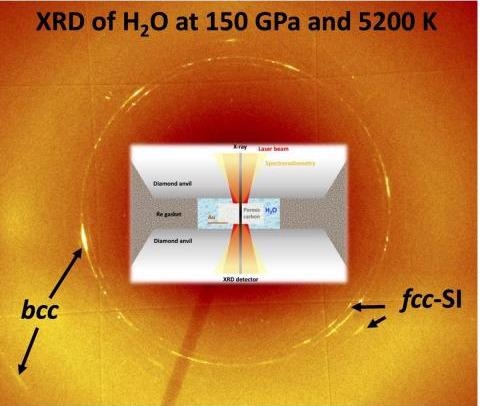New research led by the Carnegie Institution for Science and the Center of Advanced Radiation Sources at the University of Chicago revealed the conditions for the generation of the magnetic field of ice giant planets like Uranus and Neptune caused by the layer of “hot” electrically conductive ice.
 Figure illustrating how the experiments were performed, revealing two forms of superionic ice. Image Credit: Vitali Prakapenka.
Figure illustrating how the experiments were performed, revealing two forms of superionic ice. Image Credit: Vitali Prakapenka.
The study was published in the journal Nature Physics.
As taught in school, water molecules comprise two hydrogen atoms and an oxygen atom — H2O. With the change in the condition of water, the characteristics and organization of these molecules are affected. This scenario can be observed in everyday life when water is boiled into steam or frozen into ice.
The molecules that make the ordinary ice is arranged in a crystalline lattice held together by hydrogen bonds between the hydrogen and oxygen atoms. Hydrogen atoms are highly versatile implying that they can exist in significantly diverse structures. So far, 18 known forms have emerged under increasingly extreme environmental conditions.
A peculiar interest is the so-called superionic ice, which is formed at very high pressure, in which the conventional water molecule bonds get moved, enabling the hydrogen molecules to float freely in an oxygen lattice. This mobility offers the capacity for the ice to conduct electricity almost equal to a metallic material.
Contradictory results were obtained when observing hot, superionic ice created in a laboratory, where there was a significant level of disagreement regarding the specific condition under which the new characteristics emerge.
So, our research team, led by the University of Chicago’s Vitali Prakapenka, set out to use multiple spectroscopic tools to map changes in ice’s structure and properties under conditions ranging up to 1.5 million times normal atmospheric pressure and about 11,200 degrees Fahrenheit.
Alexander Goncharov. Carnegie Institution for Science
The research team — including Nicholas Holtgrewe formerly of Carnegie, now at the Food and Drug Administration in St Louis, and Sergey Lobanov, formerly of Carnegie, now at the GFZ German Research Center for Geosciences — was able to show the emergence of two forms of superionic ice. They also suggested that one of them could be found in the interiors of ice giant planets like Uranus and Neptune.
Explaining the work done using the facility’s GSECARS beamline, Prakapenka said, “In order to probe the structure of this unique state of matter under very extreme conditions—heated by a laser and compressed between two diamonds—we used the Advanced Photon Source’s brilliant high-energy synchrotron x-ray beam, which was focused down to about 3 micrometers, 30 times smaller than a single human hair.”
These experiments are so challenging that we had to run a few thousand of them over a decade to get enough high-quality data to solve the long-standing mystery of high-pressure, high-temperature behavior of ice under conditions relevant to giant planet interiors.
Vitali Prakapenka, Research Lead, University of Chicago
Goncharov stated, “Simulations have indicated that the magnetic fields of these two planets are generated in thin, fluid layers found at relatively shallow depths. The conductivity of superionic ice would be able to accomplish this type of field generation and one of the two structures we revealed could exist under the conditions found in these magnetic field-generating zones.”
More research is required to understand the conductive properties and viscosity of these stages under ice giant-interior conditions.
The study was supported by the U.S. National Science Foundation, the Army Research Office, the Deep Carbon Observatory, the Helmholtz Young Investigators Group, and the Carnegie Institution for Science. This study was performed at GeoSoilEnviroCARS, Advanced Photon Source, and Argonne National Laboratory.
Journal Reference:
Prakapenka, V. B., et al. (2021) Structure and properties of two superionic ice phases. Nature Physics. doi.org/10.1038/s41567-021-01351-8.